Please Take Note: This is a review of the final game, but it might change slightly based on the success of the Kickstarter campaign. The game is being reviewed on the components and the rules provided with the understanding that “what you see is not what you might get” when the game is published. If you like what you read and want to learn more, we encourage you to visit the game publisher’s website or visit the Kickstarter campaign. Now that we have all that disclaimer junk out of the way, on with the review.
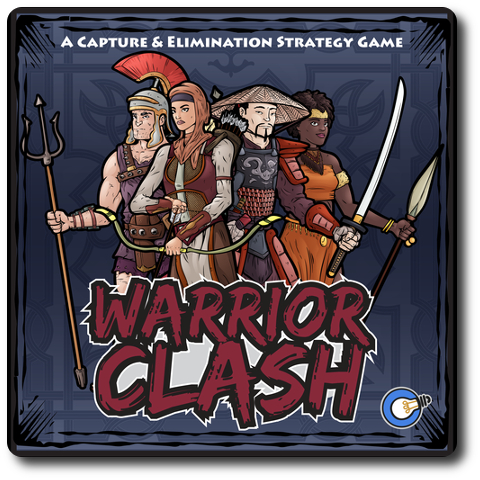
The Basics:
- For ages 8 and up
- For 2 to 4 players
- Approximately 40 minutes to complete
Geek Skills:
- Counting & Math
- Logical & Critical Decision Making
- Reading
- Pattern/Color Matching
- Strategy & Tactics
- Risk vs. Reward
- Hand/Resource Management
Learning Curve:
- Child – Easy
- Adult – Easy
Theme & Narrative:
- Warriors of the world compete to be the best
Endorsements:
- Gamer Geek rejected!
- Parent Geek approved!
- Child Geek approved!
Overview
Chinese general, military strategist, and philosopher, Sun Tzu, said ” Invincibility lies in the defense; the possibility of victory in the attack.” The actions of a warrior are dangerous and calculated, but nothing is for certain. Even when the enemy is upon you, the outcome of the battle is an unknown until the last warrior is standing. In this game, you will control warriors from distant lands. Victory will go to the bold, the brave, and the reckless.
Warrior Clash, designed by Clint Clark and to be published by Clark Creative, will reportedly be comprised of 32 Warrior tiles, 32 Strategy cards, 6 game board tiles, 32 Team makers (in 4 different colors), 4 standard six-sided dice (in 4 different colors), and 45 Base markers (in 5 different colors. As this is a review of a prepublished game, I cannot comment on the game component quality. The illustrations of the different warriors in the game (of which there are many), by artist Emmanuel Sylvester, are excellent. Each warrior has their own unique look, armor, and weaponry. Everything from the Māori to the Zulu warriors are represented
Preparing for Battle
To set up the game, first have each player select 1 game board tile. The tiles depict various terrain, both passable and impassable. Players orientate the tiles as they like, connecting them together to form rectangles and squares. An even number of tiles should be placed, meaning if the number of players is odd, randomly add 1 additional tile. However, players can ignore this rule if they so choose. The end result will be the map on which the battles will take place.
Second, each player should now take a Base token and place it on the map. This is the player’s “Home Base”.
Third, players should agree on where to place additional bases, referred to as “Remote Bases”, on the map. The Remote Bases use the white Base markers. One Remote Base should be on each game board.
Fourth, take the Warrior tiles and arrange them so they are visible to all the players.
Fifth, each player now selects 1 Warrior tile and deploys it onto the map, placing it on their Home Base. All deployed Warriors should be marked with a colored marker that matches the color of the Home Base.
Fifth, give each player the dice and marker colors that match their Home Base. Shuffle the Strategy cards and set them to one side of the game playing area, face-down.
That’s it for game set up. Determine who will go first and begin!
Clash of the Warriors
Warrior Clash is played in turns. A typical turn is summarized here. Each player is given 1 action by default. A player earns more actions by controlling bases. For example, if the player controls 2 Remote Bases and their Home Base, they would have 3 actions. The available actions are summarized below.
Action Option 1: Deploy Warrior
The player selects an unused Warrior tile and adds it to their Home Base, but only if their Home Base is unoccupied.
Action Option 2: Move Warriors
Movement can be broken up between all of the player’s currently active Warrior tiles or used by just one. Movement is always to an adjacent space (never diagonal). Warriors cannot move onto or through a space that is occupied by a Warrior tile or through spaces that are marked with a red outline.
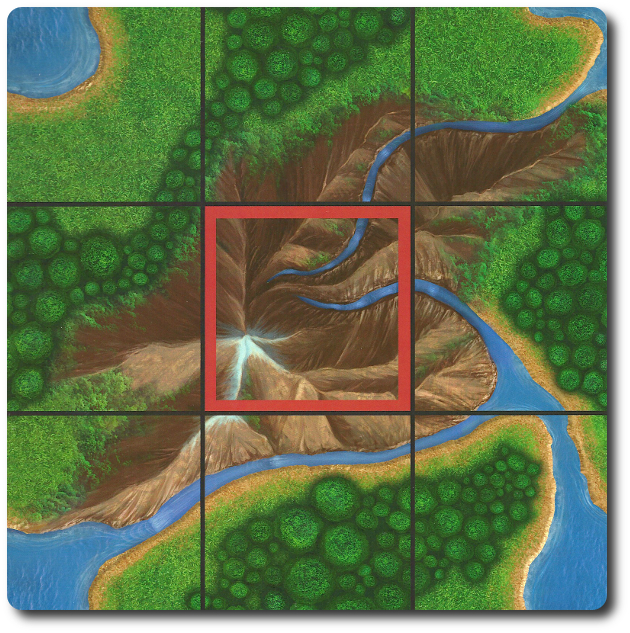
Action Option 3: Rotate One Warrior Tile
The facing of a Warrior tile is meaningful, but only when it encounters an opponent’s Warrior tile. The active player can now rotate 1 Warrior tile in any new direction they like, but it must remain on the space on which it’s currently located. The Warrior tile being rotated need not have moved this turn.
Action Option 4: Retreat One Warrior Tile
If the player likes, they can remove 1 Warrior tile from the map and add it to their hand.
Action Option 5: Play a Strategy Card
Strategy cards give the player additional tactical and resource advantages. Tactics give the player a unique action they can take. Bonuses to weapons that apply to specific warriors are considered a resource. If the Strategy card refers to a specific warrior or warrior type, the player must have that Warrior tile in play in order for the Strategy card resource to be of any use.
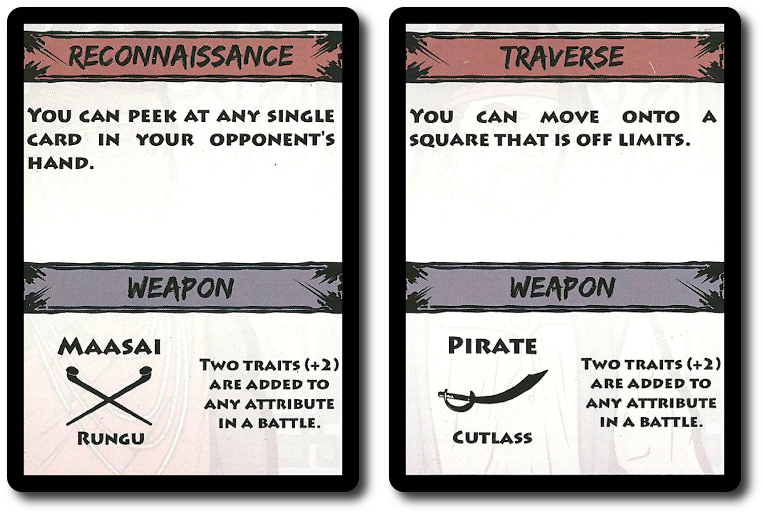
Action Option 6: Draw One Strategy Card
A maximum of 3 Strategy cards can be held by the player at any time during the game. If the player is allowed to draw a fourth Strategy card, they must discard 1 Strategy card after adding the new card to their hand.
Action Option 6: Offer a Truce
If the player likes, they can elect to not take any actions (other than this one) for their turn. This is considered a “peaceful action”, but does not guarantee the player will be left alone.
BATTLE!!!
If a player’s Warrior tile is adjacent to an opponent’s Warrior tile and the sides match, the player can elect to start a battle. Starting a battle is always optional.
Each Warrior tile has traits in Strength, Agility, Grit, and Ingenuity. The symbols next to each of these traits are the bonuses given to the Warrior tile when they use that specific trait in combat.
For example, the Musketeer and the Highlander can engage in battle since they are adjacent to each other and the trait sides match (both are matching the Agility trait). The player controlling the Musketeer gets a +3 to their Agility, while the opponent controlling the Highlander only gets a +1 to their Agility. The Highlander is at a disadvantage.
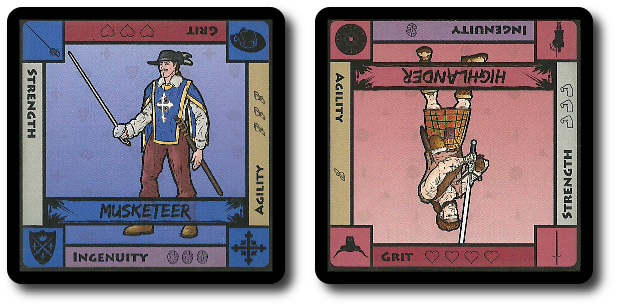
The outcome of the battle is determined by rolling the six-sided die and adding any bonuses provided by the Warrior’s traits. In addition, Strategy cards can be used to increase bonuses, but Strategy cards must be played before the dice are rolled.
A player can also use their other Warrior tiles not engaged in battle as support. This is referred to as “partnering” and can only be done with a Warrior tile that is both adjacent and of the same warrior type. Each Warrior tile has a male and female warrior. A pair is considered a “partnership”. The benefit is that the player can add both Warrior tile traits. The penalty for losing the battle, however, is severe. Instead of just losing 1 Warrior tile, the player will lose both Warrior tiles in the partnership.
For example, the Musketeer is battling the male Highlander. Little does the Musketeer know that the Highlander’s sister is close by and doesn’t take kindly to anyone who want to hurt her kin. The player who owns both Highlanders now adds a combined +2 Agility to their role.

After the dice have been rolled and Strategy cards played, both players determine the final battle value. If a player’s total battle value is 6 or greater than their opponent’s, they have captured the opponent’s Warrior tile, claiming it as their own. If the player wins against an opponent who is partnering with their Warrior tiles, they capture both regardless of their battle value. If victory is won with a 5 or less battle value, then the Warrior tiles that lost are sent to the dead pile.
Regardless of the outcome, a space will now be open on the map. The winner of the battle has a free action to move their Warrior tile into it.
Winning the Game
The game can be won by taking over an opponent’s Home Base or the first player to control a set number of Remote Bases.
Game Variants
Several game variants are available to those who want to change the base game. Each is summarized here.
Fog of War
When Warrior tiles are deployed, they are placed face-down. Only the player who controls them can view what is underneath. When a face-down Warrior tile enters combat, it’s flipped face-up and remains face-up for the duration of the game.
Pre-Reading Friendly
The game makes use of symbols and all that is necessary to enjoy the game and battles is to match those symbols. For those younger players who are having trouble reading, remove the Strategy cards from play.
No Luck
Remove the dice and the Strategy cards from the game. A Warrior’s trait strength is listed on the card and used to determine the outcome of battle.
Adjust Game Length
Adding more Warrior tiles to the game and increasing the space on which the Warrior tiles can move will increase the duration of the game. Removing Warrior tiles and reducing map space will make for a shorter game.
To learn more about Warrior Clash, visit the game publisher’s website or visit the Kickstarter campaign.
Final Word
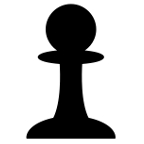 The Child Geeks quickly learned how to play the game and recognized many of the game rules from their previous experience playing Zoo Webs, another game by the same game designer. Right off the bat, it was obvious that the Child Geeks fell into one of two camps. Either they were aggressive and purposely sought out combat or they kept falling back and hiding in corners. Warrior Clash is not a game that necessarily rewards you for being aggressive, but it certainly is more fun if you are. According to one Child Geek, “You need to not be afraid to charge into a group of other warriors. You can twist your tile around so you are only being attacked in one direction.” The twisting the Child Geek mentions is all important when it comes to tactics and the warrior’s survival. Facing the tile in the wrong direction and you might leave yourself open to an easy attack. Another Child Geek said, “The game isn’t hard, which I like, but you really have to work hard to win sometimes.” When all the battles were over, the Child Geeks gave their endorsement some thought. After discussing the various pros and cons (from their perspective), they elected to give Warrior Clash their full approval.
The Child Geeks quickly learned how to play the game and recognized many of the game rules from their previous experience playing Zoo Webs, another game by the same game designer. Right off the bat, it was obvious that the Child Geeks fell into one of two camps. Either they were aggressive and purposely sought out combat or they kept falling back and hiding in corners. Warrior Clash is not a game that necessarily rewards you for being aggressive, but it certainly is more fun if you are. According to one Child Geek, “You need to not be afraid to charge into a group of other warriors. You can twist your tile around so you are only being attacked in one direction.” The twisting the Child Geek mentions is all important when it comes to tactics and the warrior’s survival. Facing the tile in the wrong direction and you might leave yourself open to an easy attack. Another Child Geek said, “The game isn’t hard, which I like, but you really have to work hard to win sometimes.” When all the battles were over, the Child Geeks gave their endorsement some thought. After discussing the various pros and cons (from their perspective), they elected to give Warrior Clash their full approval.
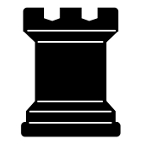 The Parent Geeks liked a lot of the same things as the Child Geeks, but also made mention of how simple it would be to make your own type of games given the easy to understand and flexible base rules. According to one Parent Geek, “The core of the game is built around simple movement and facing. I can see myself easily adding in more complex movement rules and combat modifiers without upsetting the game’s balance.” I agree. The game is open enough to interpretation, but not so open as to allow anyone to break it. As one Parent Geek put it, “The game wants you to play it your way and you can add new rules and challenges as you like. For example, if your Warrior tile is in a fortress, you get a +2 to your roll if defending. Or how about getting a bonus if you are being attacked on your map tile. Kind of like a home field advantage.” The possibilities are many and the Parent Geeks recognized that. To them, this gave Warrior Clash great value. As a result, they fully approved the game.
The Parent Geeks liked a lot of the same things as the Child Geeks, but also made mention of how simple it would be to make your own type of games given the easy to understand and flexible base rules. According to one Parent Geek, “The core of the game is built around simple movement and facing. I can see myself easily adding in more complex movement rules and combat modifiers without upsetting the game’s balance.” I agree. The game is open enough to interpretation, but not so open as to allow anyone to break it. As one Parent Geek put it, “The game wants you to play it your way and you can add new rules and challenges as you like. For example, if your Warrior tile is in a fortress, you get a +2 to your roll if defending. Or how about getting a bonus if you are being attacked on your map tile. Kind of like a home field advantage.” The possibilities are many and the Parent Geeks recognized that. To them, this gave Warrior Clash great value. As a result, they fully approved the game.
 The Gamer Geeks found Warrior Clash to be too simple and too light to be of any real interest to them. Worse yet, they “broke” the game within the first 5 minutes of playing it. According to one Gamer Geek, “The rules are not clear enough to describe some of the most basic actions. I’m still not sure if we set the game up right or we are playing it as the designer intended.” The Gamer Geeks also found out that there is nothing stopping a player from simply running around and avoiding combat. Yes, eventually they will lose movement due to lack of controlled bases, but until then, they can just keeping skipping combat. The Gamer Geeks didn’t think this type of behavior would be common, but nor did they approve of it being allowed by the game in the first place. As one Gamer Geek put it, “If you are going to have a game about warriors clashing, you best make sure they do so and often.” When the games were over, Warrior Clash lost the fight against the gaming elitists.
The Gamer Geeks found Warrior Clash to be too simple and too light to be of any real interest to them. Worse yet, they “broke” the game within the first 5 minutes of playing it. According to one Gamer Geek, “The rules are not clear enough to describe some of the most basic actions. I’m still not sure if we set the game up right or we are playing it as the designer intended.” The Gamer Geeks also found out that there is nothing stopping a player from simply running around and avoiding combat. Yes, eventually they will lose movement due to lack of controlled bases, but until then, they can just keeping skipping combat. The Gamer Geeks didn’t think this type of behavior would be common, but nor did they approve of it being allowed by the game in the first place. As one Gamer Geek put it, “If you are going to have a game about warriors clashing, you best make sure they do so and often.” When the games were over, Warrior Clash lost the fight against the gaming elitists.
 In my opinion, Warrior Clash is a great example of a gateway Wargame. It has all the elements of a Wargame, but lacks the depth and difficulty that make so many Wargames difficult to learn how to play. However, by simplifying Warrior Clash, so too did the designer reduce the game’s depth of play and strategic actions. The game is little more than move and attack. The facing of the Warrior tile is the most difficult aspect and a player must leave themselves actions to rotate for battle, but even then surviving combat isn’t very difficult since both Warrior tiles must be in alignment. More than once, we had Warrior tiles facing each other in the wrong direction. Adjacent and ready to fight, but unable to.
In my opinion, Warrior Clash is a great example of a gateway Wargame. It has all the elements of a Wargame, but lacks the depth and difficulty that make so many Wargames difficult to learn how to play. However, by simplifying Warrior Clash, so too did the designer reduce the game’s depth of play and strategic actions. The game is little more than move and attack. The facing of the Warrior tile is the most difficult aspect and a player must leave themselves actions to rotate for battle, but even then surviving combat isn’t very difficult since both Warrior tiles must be in alignment. More than once, we had Warrior tiles facing each other in the wrong direction. Adjacent and ready to fight, but unable to.
I really liked the different warriors in the game, but was disappointed with their lack of uniqueness. All the Warrior tiles are basically the same except for the Warrior type, which is used for partnering and Strategy cards. Most of the game is simply playing the numbers game against other Warrior tiles. When you do have a Strategy card that matches your Warrior tile, it’s something of a temporary game changer, as the Strategy card gives to the player something no other opponent can directly defend. While that may sound overly powerful, its limited use keeps abusing such cards in check.
Overall, I found Warrior Clash to be an interesting game, design-wise, but not an overly entertaining game. My kids liked it, their friends liked it, and the Parent Geeks liked playing it with their families. Like the Gamer Geeks, I didn’t feel that the game went far enough with its battles, strategies, and tactics. It’s not that the game felt dumbed-down – far from it – but it did feel half-made. I couldn’t help shake the feeling that I wasn’t being given all the information. Small holes were everywhere that could be easily filled, but it bothered me that there were any holes to begin with. In the end, I view the game as an interesting distraction and a good teaching aid for those who want to teach others how to play Wargames. But other than that, it’s not a game for me. Give it a try and see if it clashes with your idea of an entertaining game or not.
This is a paid for review of the game’s final prototype. Although our time and focus was financially compensated, our words are our own. We’d need at least 10 million dollars before we started saying what other people wanted. Such is the statuesque and legendary integrity of Father Geek which cannot be bought except by those who own their own private islands and small countries.



